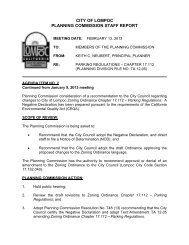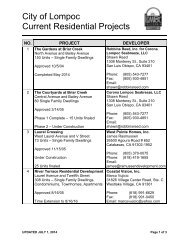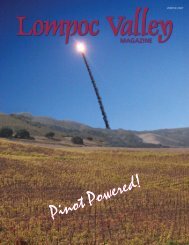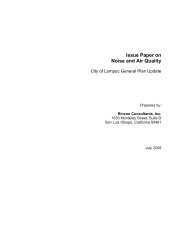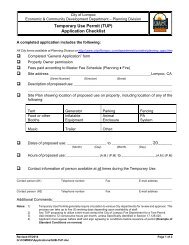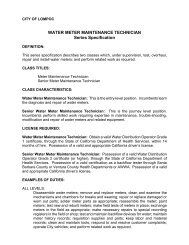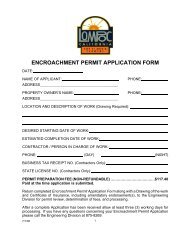Storm Water Pollution Prevention Plan (SWPPP) - the City of Lompoc!
Storm Water Pollution Prevention Plan (SWPPP) - the City of Lompoc!
Storm Water Pollution Prevention Plan (SWPPP) - the City of Lompoc!
You also want an ePaper? Increase the reach of your titles
YUMPU automatically turns print PDFs into web optimized ePapers that Google loves.
12Sediment Risk Factor WorksheetA) R FactorA B CEntry345678Analyses <strong>of</strong> data indicated that when factors o<strong>the</strong>r than rainfall are held constant, soil loss is directly proportional to arainfall factor composed <strong>of</strong> total storm kinetic energy (E) times <strong>the</strong> maximum 30-min intensity (I30) (Wischmeier andSmith, 1958). The numerical value <strong>of</strong> R is <strong>the</strong> average annual sum <strong>of</strong> EI30 for storm events during a rainfall record <strong>of</strong>at least 22 years. "Isoerodent" maps were developed based on R values calculated for more than 1000 locations in <strong>the</strong>Western U.S. Refer to <strong>the</strong> link below to determine <strong>the</strong> R factor for <strong>the</strong> project site.http://cfpub.epa.gov/npdes/stormwater/LEW/lewCalculator.cfmB) K Factor (weighted average, by area, for all site soils)R Factor ValueThe soil-erodibility factor K represents: (1) susceptibility <strong>of</strong> soil or surface material to erosion, (2) transportability <strong>of</strong> <strong>the</strong>sediment, and (3) <strong>the</strong> amount and rate <strong>of</strong> run<strong>of</strong>f given a particular rainfall input, as measured under a standardcondition. Fine-textured soils that are high in clay have low K values (about 0.05 to 0.15) because <strong>the</strong> particles areresistant to detachment. Coarse-textured soils, such as sandy soils, also have low K values (about 0.05 to 0.2)because <strong>of</strong> high infiltration resulting in low run<strong>of</strong>f even though <strong>the</strong>se particles are easily detached. Medium-texturedsoils, such as a silt loam, have moderate K values (about 0.25 to 0.45) because <strong>the</strong>y are moderately susceptible toparticle detachment and <strong>the</strong>y produce run<strong>of</strong>f at moderate rates. Soils having a high silt content are especiallysusceptible to erosion and have high K values, which can exceed 0.45 and can be as large as 0.65. Silt-size particlesare easily detached and tend to crust, producing high rates and large volumes <strong>of</strong> run<strong>of</strong>f. Use Site-specific data mustbe submitted.Site-specific K factor guidance24.629K Factor Value1101112C) LS Factor (weighted average, by area, for all slopes)The effect <strong>of</strong> topography on erosion is accounted for by <strong>the</strong> LS factor, which combines <strong>the</strong> effects <strong>of</strong> a hillslope-lengthfactor, L, and a hillslope-gradient factor, S. Generally speaking, as hillslope length and/or hillslope gradient increase,soil loss increases. As hillslope length increases, total soil loss and soil loss per unit area increase due to <strong>the</strong>progressive accumulation <strong>of</strong> run<strong>of</strong>f in <strong>the</strong> downslope direction. As <strong>the</strong> hillslope gradient increases, <strong>the</strong> velocity anderosivity <strong>of</strong> run<strong>of</strong>f increases. Use <strong>the</strong> LS table located in separate tab <strong>of</strong> this spreadsheet to determine LS factors.Estimate <strong>the</strong> weighted LS for <strong>the</strong> site prior to construction.LS Table1314151617181920LS Factor Value<strong>Water</strong>shed Erosion Estimate (=RxKxLS) in tons/acreSite Sediment Risk FactorLow Sediment Risk: < 15 tons/acreMedium Sediment Risk: >=15 and = 75 tons/acre24.62Medium0



